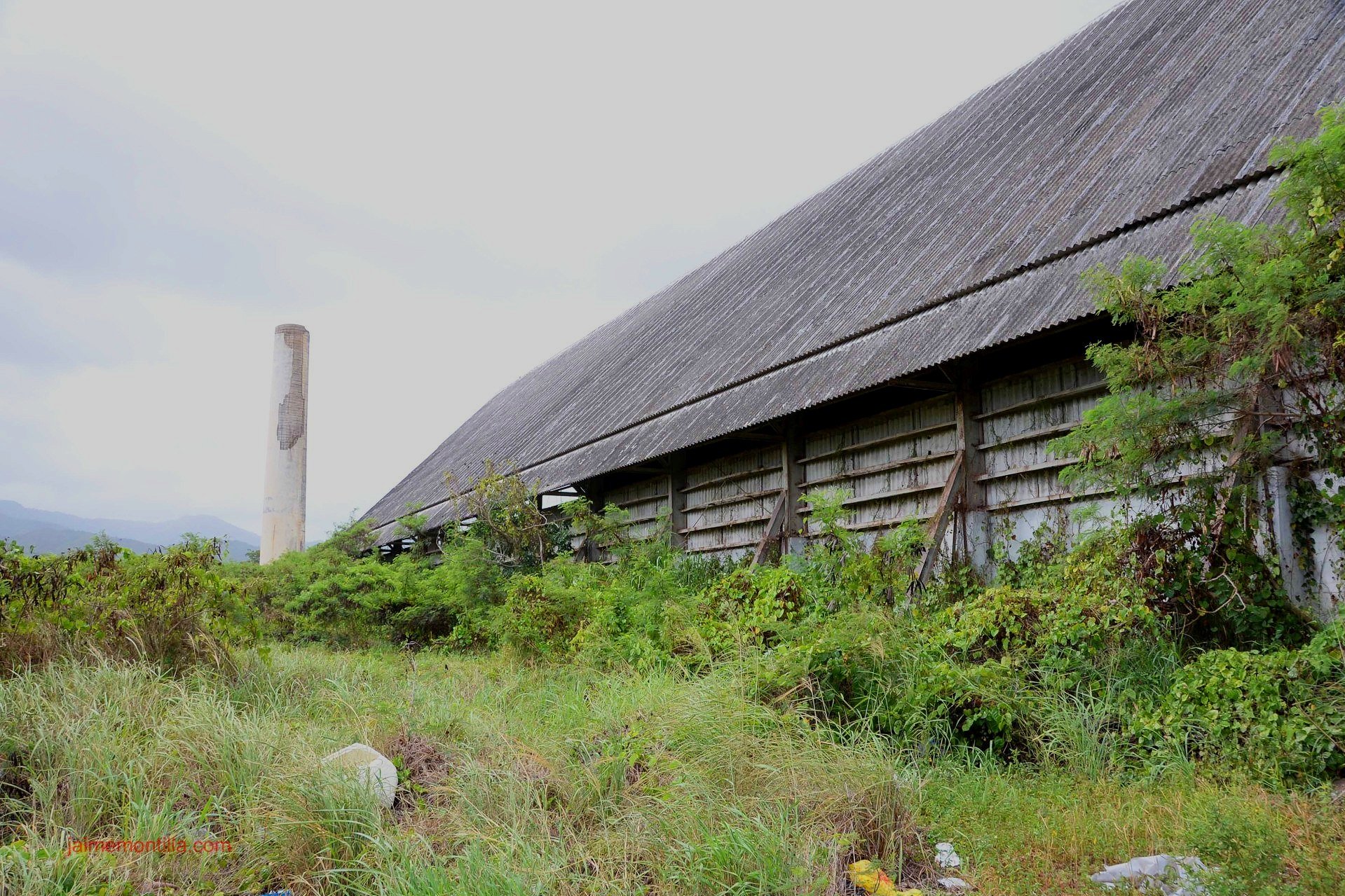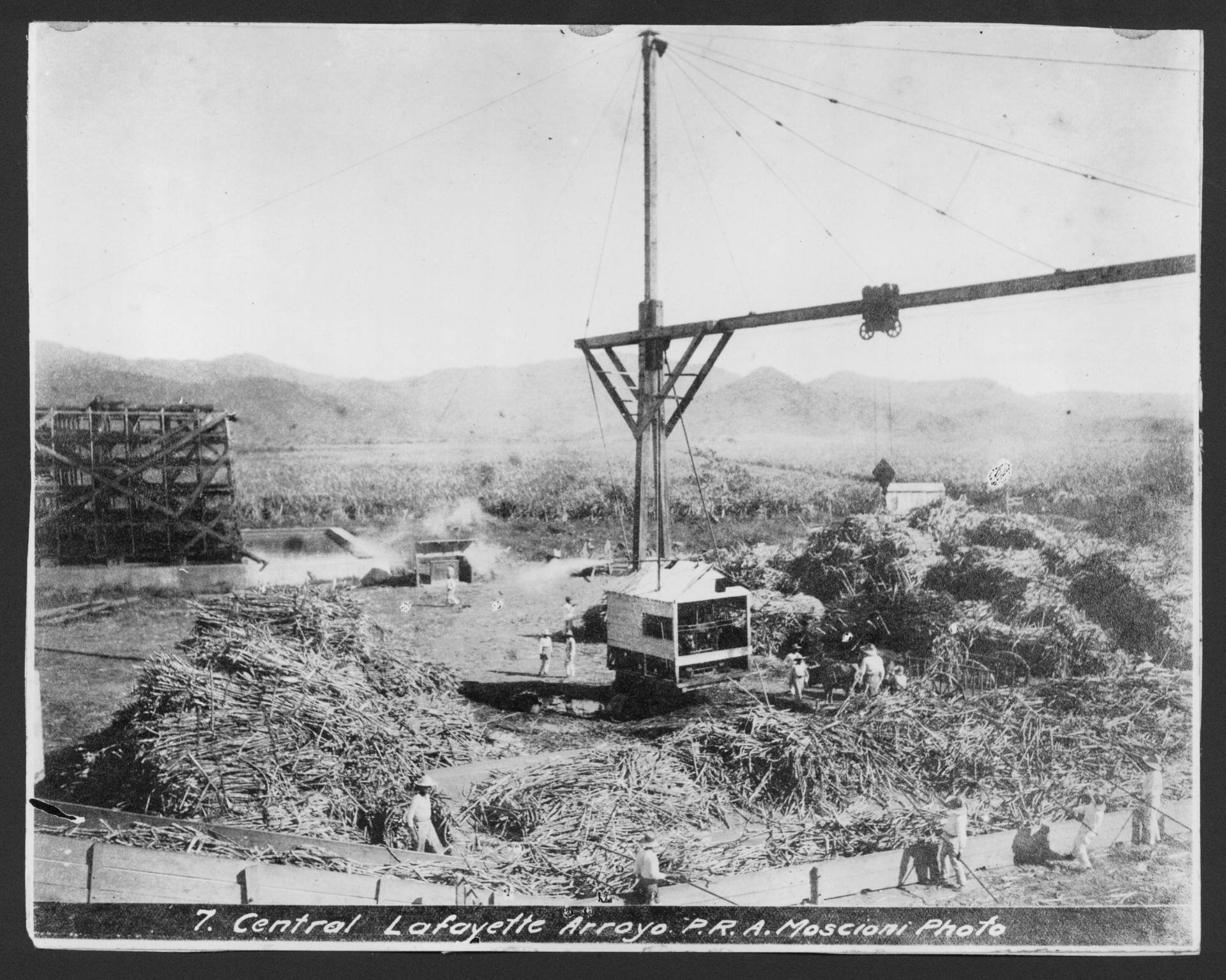
Central Lafayette
Location: Aguirre
Date Established: 1905
Date Ceased Operations: 1973
Annual Production Graph
Average Annual Production: 24,368 Tons
Best Production Year: 1949/40,693 Tons
Family Ownership: Fantauzzi
Corporate Ownership: Asociacion Azucarera Cooperativa Lafayette
The arrival of foreign nationals in Puerto Rico was prompted by the 1815 Royal Decree of Graces approved by King Ferdinand VII of Spain which allowed citizens of European countries other than Spain to settle in Puerto Rico. As a result, German, French, Corsican, Danish, US nationals and others emigrated to Puerto Rico in search of a better life and fortune.
According to Gloria Tapia Rios in her book La Central Lafayette: Riqueza, Desarrollo y Política en el Sureste de Puerto Rico, the first document known to evidence a member of the Fantauzzi family from Corscia residing in Arroyo is made by historian Cristobal Sanchez in his Cartilla Histórica. Sanchez mentions Angel Francisco Fantauzzi Stella (1813-1891) as a distinguished merchant of Corsican origin that lived in Guayama by 1844 (Arroyo was not chartered as a town until 1855). Fanatauzzi was appointed "Repartidor de Comercio" in 1851, a sign he was indeed a respected citizen. The Repartidor de Comercio was the person responsible for approving the tax and other collections related to business activities for the municipality.
In 1852 at the request of Angel Francisco, his nephews José (1832-1905) and Cruciano (1826-1896) Fantauzzi Stella, the sons of Antonio Mateo Fantauzzi Stella and Maragrita Stella arrived in Arroyo from Morsiglia. On April 30, 1853 they signed an agreement to acquire all of Angel Francisco's business assets for 34,934 pesos macuquinos. On June 20, 1853 the mercantile firm Fantauzzi Hnos. was organized by José and Cruciano to continue the business they had acquired from their uncle. The establishmnet of Fantauzzi Hnos. was the beginning of what fifty two years later would be Central Lafayette.
In 1857 Angel Francisco appears to have been involved in slave trade. That year he bought Hacienda Rio Grande in Patillas which included eighty one acres and a sugar factory. In 1873 he relocated to Arroyo where he got involved in local politics, he died in Morsiglia in 1891.
José Fantauzzi Stella married Paris born Marie Antoinette Gautier Mariani and returned to reside in Marseille in 1874. Cruciano married Coudun, France born Matilde Catalina Joubert Marcucci and returned to reside in Paris in 1878. By 1874, two other brothers, François (1835-1924) and Jérôme (1846-1906) had also emigrated to Puerto Rico from Corsica. When José and Cruciano returned to live in France, they became absentee owners of their crop financing and most lucrative business as well as their sugar and molasses exporting business which were then managed by François and Jérôme who became partners in Fantauzzi Hnos. that year.
In 1896 José acquired SUCRERIE DE COUDUN, a beet sugar refining business northeast of Paris in Coudun, France. Upon his death it was inherited and operated until around 1970 by his sons Antoine Mathieu and Jules Fantauzzi Gautier. A second generation of Fantauzzis later joined in the business, José's son Antonio Fantauzzi Gautier (1881- ) joined in 1903 and in the 1920s Jérôme's sons José (1881-1953) and Gregorio (1886-1973) Fantauzzi Manatou, both born in Arroyo, also joined the business.
Not mentioned in the records of the Fantauzzi's in Arroyo is another brother, Mateo Fantauzzi Stella (1837-1894) who arrived in Puerto Rico in 1857. In 1871 Mateo married Francisca Faustina Cora Hernandez (1851-1874) in Arroyo. The couple returned to Bastia, Corsica where Francisca died on July 25, 1874 just three years after their marriage. Also not mentioned is another brother, Juan Bautista Fantauzzi Stella (1829-1894) who arrived in Puerto Rico in 1852. He eventually returned to Morsiglia where together with mateo they built the Chateau Fantauzzi, one of the so called "House of Americans" in Corsica.
Throughout the years, Fantauzzi Hnos. acquired several haciendas for non-payment of crop financing contracts. In 1862 they acquired one half of Hacienda Garonne in Maunabo from Cruciano's mother-in-law Rosalía Marcucci, the widow of Juan Joubert. They acquired the other half in 1873 when they paid 130,000 Francs to the estate of Juan Joubert which in addition to his wife included Maria Emilia Joubert Marcucci, Magdalena Joubert Marcucci and their mother Rosalía Marcucci.
In 1857 they acquired the eight hundred acre Hacienda Felícita in Patillas from Francisco Agostini and the two hundred sixty five acre Hacienda Emilia from the estate of St. Thomas born Santiago Reys (1791-1856). In 1858 they acquired the fifty acre Hacienda Palma in Arroyo from Concepción Altuna and her husband Francisco Monserrate Lopez. All these acquisitions became important contributions to the foundation of Central Columbia and Central Lafayette.
Central Lafayette was the result of the consolidation of haciendas Cuatro Calles, Ancones and Palma, being the four hundred eighty nine cuerdas Hacienda Cuatro Calles the center of the new venture. Hacienda Cuatro Calles was owned by Luis Buenaventura Sanchez who died leaving the property subject to a $40,000 mortgage. In 1836 Francisco Carlos Tracy (1804-1846) married Barbanera Sanchez who was ½ owner of Hacienda Cuatro Calles. In 1843 Tracy acquired an additional ¼ of hacienda Cuatro Calles from Manuel Cintrón and his wife Victoriana Sanchez in lieu of payment of a debt and leased together with his brother Guillermo Enrique and additional ⅓ of the Hacienda for a fourteen year term. In 1846 Hacienda Cuatro Calles had a steam mill installed.
Hacienda Cuatro Calles was acquired in 1871 by Arthur McCormick Fitzpatrick who in 1874 sold it to the mercantile firm William Lamb-Nash & Co., owners in 1887 of Central Progreso in Carolina. Fantauzzi Hnos. leased and operated Cuatro Calles from 1886 to 1892 and acquired it in October 1893 when it was auctioned by the Government due to Lamb-Nash & Co.'s insolvency.
Starting in the 1880s the Fantauzzi's continuously updated the machinery in all of their haciendas including Cuatro Calles to keep up with the changing circumstances in part brought about by the abolition of slavery in 1873. These updates at one point in time elevated Cuatro Calles to a Central Sugar Factory, however, the exact date of the organization of Lafayette as a central sugar mill is not clear.
It is 1905 when when the name "Central Lafayette de C & J Fantauzzi" begins to appear in legal documents. Before then, Cuatro Calles was mentioned in reference to Lafayette. Sucrs. C & J Fantauzzi was organized after the death of Cruciano in 1896 and José in 1905 to engage in the agricultural, industrial and commercial business of Central Lafayette as well as of those of the haciendas Cuatro Calles, Palma, Felicita, La Vega, Garonne and the Columbia Sugar Mill in Maunabo.
The February 3, 1912 edition of The Louisiana Planter and Sugar Manufacturer reports that "Central Lafayette, in the Guayama District, will soon be ready to grind...the proprietor, Don Antonio Fantauzzi, attends strictly to business during the crop, and afterwards usually returns to his home in Paris to enjoy a well-earned vacation, and he is to be congratulated for having one of the best centrals in Puerto Rico as a result of his application to business and perseverance. This is one of the few centrals which has not changed hands for many years, but has steadily been built up from a muscovado mill to an important central with a crop of about 80,000 bags."
Sucrs. C & J Fantauzzi acquired Central Providencia in Patillas in 1929 after it was destroyed by Huricane San Felipe of 1928 mainly for its land and railroad lines. Though not a big sugar mill production wise with maximum annual production of about 40,000 tons, Central Lafayette was a pioneer in several ways. It reportedly had the largest crushing mill of all sugar mills on the island and was one of the first, if not the first, to have telephone and telegraph service.
The first telegraph line in Puerto Rico was laid in Arroyo by Samuel Finley Breese Morse himself. Susan Walker Morse (1821-1885), Morse's oldest daughter, would often visit her uncle Charles Pickering Walker who owned Hacienda Concordia. During one of her visits, she met and later married Edward Lind, a Danish merchant who worked in his brother-in-law's Hacienda Enriqueta. Lind purchased the Enriqueta from his sister when she became a widow and at the same time also acquired Hacienda Concordia. Morse, who often visited at the hacienda with his daughter and son-in-law, set a two-mile telegraph line connecting his son-in-law's hacienda to their warehouse in the Arroyo port area. The line was inaugurated on March 1, 1859.
The Fantauzzi's business savvy motivated the sale of Lafayette at a time when it was generating substantial profits. In 1936, the Lafayette sugar factory and 10,000 acres were sold for a reported $3,815,000 to the Puerto Rico Reconstruction Administration (PRRA), the 1935 Puerto Rico branch of FDR's New Deal. Out of the 10,000 acres, the land not used for pasture was to be divided among former laborers and "colonos" into 314 farms mostly between five and ten acres each. The mill was to be operated cooperatively by the Asociación Azucarera Cooperativa Lafayette that had been organized that same year. The cooperative was to pay back the PRRA its $1.3 million investment over a 20 year period. In an effort to better utilize by-products, in 1938 the PRRA granted an administration loan to Asociación Azucarera Cooperativa Lafayette to build a plant for the manufacture of solvents from molasses, mainly butyl alcohol and acetone which plant was completed in 1939.
El Mundo newspaper edition of November 29,1939 publishes an article informing that Miles H. Fairbanks, then Regional Administrator of the PRRA, appointed an independent committee to study the current and future affairs of the Asociación Azucarera Cooperativa Lafayette and if it had achieved the social and economic objectives it was intended to accomplish. Although the Asociación Azucarera Cooperativa Lafayette was a private legal entity, the PRRA had inherence in its affairs due to its finanacial investment in it.
It is unbeknown to us at this time the recommendations made by the above mentioned committee and when and how the PRRA investment was paid off. The Asociación Azucarera Cooperativa Lafayette operated Central Lafayette until 1973 when it was acquired by the PR Land Authority and never operated again.
The inscription on green building with the white columns in the gallery below states "Laboratorio Quimico", which indicates this was the sugar mill's laboratory. The residential structures pictured are near where the main structure is and date back to the sugar mill days.
The book La Central Lafayette: Riqueza, Desarrollo y Politica en el Sureste de Puerto Rico by Gloria Tapia Rios includes a detailed history of the creation of Central Lafayette which name is said to refer to the address of the Fantauzzi's offices in Paris; 62 Rue Lafayette.




